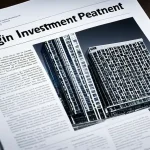Impact of Property Insurance on Real Estate Market Trends
Understanding how insurance shapes property dynamics
The property insurance impact on real estate market trends is significant. Property insurance provides a safety net that enhances market stability by mitigating risks related to damage or loss. This assurance encourages both buyers and sellers to participate confidently, knowing financial repercussions of unforeseen events are lessened.
Also read : How Can You Safeguard Your Property Investment in the Face of Unpredictable UK Weather?
When property insurance policies offer comprehensive coverage, they positively influence property values. Insured properties are often valued higher due to reduced investment risk. This value boost reflects the confidence buyers have in secured assets, which promotes healthy transaction volumes.
Moreover, the property insurance impact directly affects decision-making. Prospective buyers may prioritize homes with robust insurance options to avoid future costs. Sellers might be more motivated to maintain or upgrade properties to qualify for better insurance terms, thereby improving their selling potential.
In the same genre : How Can Property Insurance Impact the Stability of the UK Finance Sector?
In fluctuating market conditions, property insurance can stabilize trends by preventing sharp declines in sales or values caused by fear of loss. The presence of insurance reduces uncertainty, which is a major factor in real estate transactions. Overall, the property insurance impact fosters a more predictable and attractive real estate market environment.
Economic and Investment Implications
Insurance costs play a crucial role in shaping real estate investment decisions. Rising insurance premiums increase the overall cost of property ownership, which can deter investors from entering or expanding in certain markets. High insurance expenses may lead to a reassessment of potential returns, making some properties less attractive compared to others with lower associated risks and costs.
Shifts in investment patterns often follow changes in insurance availability. When insurance becomes scarce or prohibitively expensive, investors might redirect their funds toward regions or property types with more stable and affordable coverage options. This migration influences local real estate markets by altering demand, pricing, and development activity.
Risk assessment practices by lenders are also impacted. As insurers adjust coverage terms and premiums based on evolving economic trends and risk factors, lenders must incorporate these variables into their evaluation of loan applications. Higher insurance costs signal elevated risks, prompting stricter lending criteria or higher interest rates, which in turn affect investment flow.
Understanding these economic trends is essential for investors aiming to make informed decisions. Monitoring insurance market shifts and their ripple effects on real estate can help anticipate changes in market dynamics and optimize investment strategies accordingly.
Regulatory Changes and Recent Developments
Understanding the evolving landscape
Recent insurance regulations have significantly influenced both the insurance and property markets. Stringent requirements aim to enhance consumer protection while encouraging transparency and sustainability. These changes impact how insurers set premiums and assess risks, affecting property owners and buyers alike.
Natural disasters such as wildfires and floods are a driving force behind many of these policy shifts. Their increasing frequency and severity push lawmakers to revise guidelines to better manage risks and ensure financial resilience. This connection between environmental events and legislative updates is critical for market participants to understand.
For example, after a series of devastating floods, several states introduced regulations mandating more comprehensive flood coverage and stricter building codes. These legislative updates can lead to higher insurance costs but also stimulate improvements in property standards, ultimately shaping market dynamics.
In effect, these regulatory changes shape insurer behavior and market offerings, responding to both natural disasters and evolving risk landscapes. Staying informed about these developments helps homeowners, buyers, and professionals anticipate market trends and make prudent decisions.
Expert Insights and Data-Driven Analysis
Delving into expert analysis reveals clear intersections between insurance trends and real estate market shifts. Recent insurance research highlights that properties in high-risk zones face rising premiums due to increasing climate-related hazards. This correlation is supported by market data showing that property values fluctuate in tandem with insurance cost adjustments, reflecting buyer sensitivity to coverage expenses.
Notable real estate statistics demonstrate a 15% increase in insurance claims linked to natural disasters over the past five years, underpinning the growing influence of environmental factors on market dynamics. Experts emphasize that risk assessment models are evolving, incorporating advanced analytics to predict and mitigate losses more effectively.
Industry leaders note that these changes present challenges but also opportunities for smarter investment and policy development. This emerging synergy between insurance and real estate underscores the need for continuous monitoring of both sectors, ensuring stakeholders make informed decisions based on the latest market data and insurance trends. With insurance research advancing rapidly, understanding these correlations is crucial for anticipating future shifts in real estate valuations and risk profiles.
Practical Implications for Buyers, Sellers, and Investors
Understanding property insurance trends is crucial for informed buyer decisions. When purchasing a home, buyers should closely evaluate insurance premiums as these reflect risk exposure, directly influencing affordability and long-term costs. For example, homes in areas prone to natural disasters often have higher insurance rates, which may affect a buyer’s willingness to proceed or negotiate price adjustments.
Sellers must consider how rising insurance costs impact marketability. Properties with prohibitively expensive insurance may deter potential buyers, leading sellers to factor insurance expenses into their asking prices or invest in risk mitigation measures to lower premiums. This consideration increasingly shapes seller strategies in competitive markets.
Investors approach insurance-driven market dynamics strategically, looking to balance risk and returns. They often prioritize properties with manageable insurance costs and may diversify portfolios across regions with varying risk profiles. Some investors proactively partner with insurers or adopt enhanced safety features to optimize insurance terms.
When assessing property insurance, all parties should review coverage terms, claim histories, and future rate projections. This assessment helps anticipate costs and supports decision-making that aligns with financial goals, whether buying a home, selling a property, or optimizing an investment strategy.


